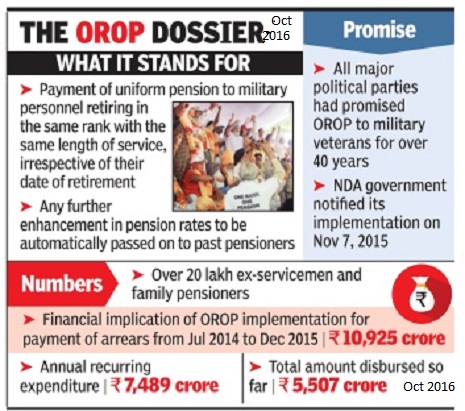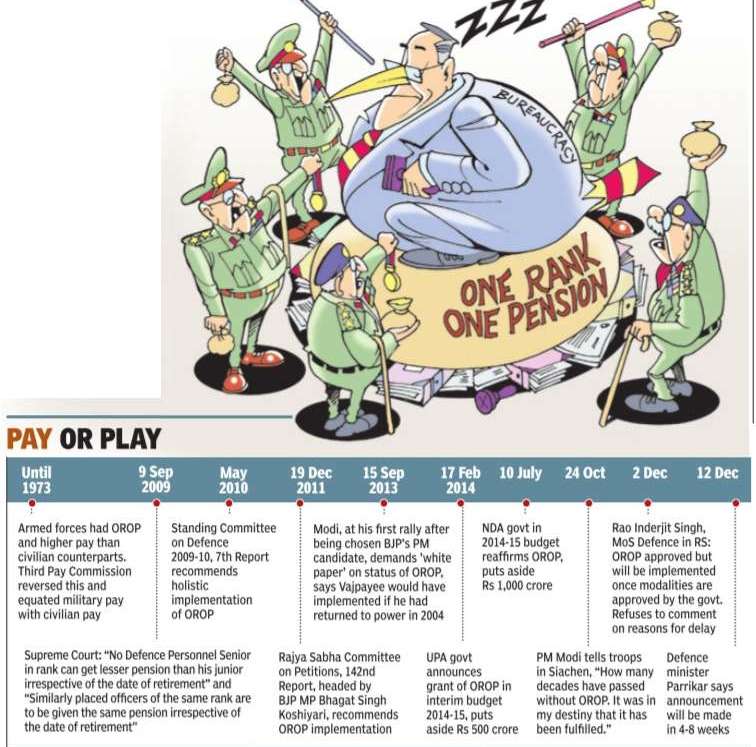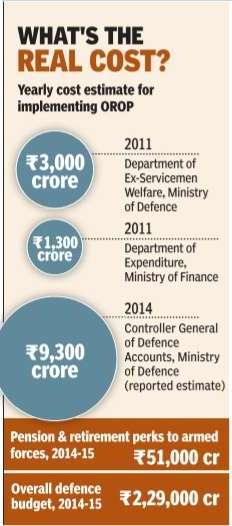One-Rank-One-Pension



This is a collection of articles archived for the excellence of their content. |
What is OROP?
The Times of India, Sep 06 2015

`One rank one pension' refers to payment of uniform pension to military personnel retiring in the same rank with the same length of service, irrespective of their date of retirement. This also includes any further enhancement in pension rates to be automatically passed on to past pensioners. The UPA government had announced OROP but left it to the NDA government to implement it. Veterans have been protesting in Delhi against the delay in implementing OROP .They have been insisting that the pensions be revised once a year but the government has opted for a reset every five years. For the current fiscal year, the government has budgeted Rs 54,500 crore for defence pension.
UPA had ini tially allocated only Rs 500 crore for OROP. The veterans were demanding that OROP be imple mented from April 1, 2014.
What is the status of Central government employees?
For central government employees (civilians), the government appoints a Pay Commis sion which revises the pay and pensions every 10 years. These recommendations become a benchmark for state-run firms and other government entities. Civilians who joined the central government from January 2004 have contributory pension under the National Pension Scheme which means they have to contribute 10% of their basic salary with a matching contribution from the government. Nearly all state government have opted for NPS while, even after 11 years, defence personnel are outside the ambit of NPS and the government funds the entire liability from the budget.
2014
OROP- Still a distant dream to be implemented
Nalin Mehta, December 14, 2014
Roman emperor Augustus started the tradition of military pensions in 13 BC, when every legionary who had fought 20 years for Rome was guaranteed a pension for-life. It set the bar for modern armies, and independent India continued the British tradition of financially privileging military service until the mid-1970s, when soldiers were paid more than civilian bureaucrats, in service and after retirement. All that changed with the Third Pay Commission, which brought military salaries in line with civil services, and while soldiers have long complained about political control over the military in independent India mutating into bureaucratic control, a row over the NDA's promise for one-rank-one-pension (OROP) for military veterans is raising questions about the government's ability to translate its intent into action. Many distinguished veterans argue that they are only asking for what was promised to them, pointing to the aphorism of Chankaya, the architect of the Mauryan empire, who is said to have advised his prodigy Chandragupta Maurya that: “The day a soldier has to demand his dues will be a sad day for Magadha. From then on you have lost all moral sanctions to be King.”
OROP means that every pension-eligible soldier who retires in a particular rank deserves the same pension, irrespective of date of retirement. Currently, soldiers who left the armed forces more recently receive more than those who did earlier, because successive pay commissions hiked salaries. SOLDIERS vs CIVILIANS
The case for OROP is predicated on military terms of service being much harsher than those for civil services. Most soldiers retire between 35-37 years of age, while officers below brigadier-or-equivalent do so at 54, with limited re-employment options. Civil servants, in contrast, retire at 60.
Moreover, the Sixth Pay Commission granted the facility of what bureaucrats call “non-functional upgrade” (NFU) to officers in all-India Group A services. This is a sort of ‘pay-promotion', allowing them, under certain conditions, to draw higher pay than their rank, without actually being promoted. Almost all civil servants benefit from this while defence services officers do not, even as their career pyramid is much steeper. Only 0.8% of defence officers make it to the rank of major general after 28 years of service, compared with a much higher rate of civil servants who are eligible to become joint secretaries at 19 years of service.
OROP scheme announced by government in September 2015: Some highlights
The Times of India, 5 Sep, 2015

The Times of India
Here are the highlights of Defence minister Manohar Parrikar's announcement on the OROP ("one rank, one pension") scheme announced on 5 Sept 2015:
1. OROP will be implemented from July 1, 2014 and the base year would be 2013.
2. The estimated cost to implement OROP would be between Rs 8,000 crore to Rs 10,000.
3. Pension of ex-servicemen will be revised every five years.
4. Re-fixed pension will be the average of minimum and maximum pension in 2013.
5. OROP arrears to be paid in 4 half-yearly installments.
6. Those drawing pensions above the average will be protected.
7. A one-member judicial committee will be constituted. It will give reports on equalisation period in 6 months.
8. Personnel who retire voluntarily will not be covered under OROP scheme.

